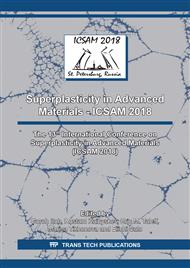p.45
p.53
p.59
p.65
p.72
p.78
p.84
p.91
p.97
Room Temperature Superplasticity in Fine/Ultrafine-Grained Zn-Al Alloys with Different Phase Compositions
Abstract:
Three Zn-Al alloys, namely Zn-22Al, Zn-5Al and Zn-0.3Al, were subjected to equal-channel angular pressing (ECAP), and the effect of ECAP on their microstructure and room temperature (RT) superplastic behavior were investigated in detail referring to previous studies reported by the authors of the current study. ECAP remarkably refined the microstructures of three alloys as compared to their pre-processed conditions. While the lowest grain size was achieved in Zn-22Al alloy as 200 nm, the grain sizes of Zn-5Al and Zn-0.3Al alloys were ~540 nm and 2 µm, respectively, after ECAP. After the formation of fine/ultrafine-grained (F/UFG) microstructures, all Zn-Al alloys exhibited superplastic behavior at RT and high strain rates. The maximum superplastic elongations were 400%, 520% and 1000% for Zn-22Al, Zn-5Al and Zn-0.3Al alloys, respectively. It is interesting to point out that the highest RT superplastic elongation was obtained in Zn-0.3Al alloy with the largest grain size, while Zn-22Al alloy having the lowest grain size showed the minimum superplastic elongation. This paradox was attributed to the different phase compositions of these alloys. The formation of Al-rich α/α phase boundaries, where grain boundary sliding is minimum comparing to Zn-rich η/η and η/α phase boundaries of Zn-Al alloys, is the lowest level in Zn-0.3Al alloy among all the alloys. Therefore, it can be concluded that if it is desired to achieve high superplastic elongation in Zn-Al alloys at RT, keeping Al content at a possibly minimum level seems to be the most suitable way.
Info:
Periodical:
Pages:
72-77
Citation:
Online since:
July 2018
Authors:
Price:
Сopyright:
© 2018 Trans Tech Publications Ltd. All Rights Reserved
Share:
Citation:


